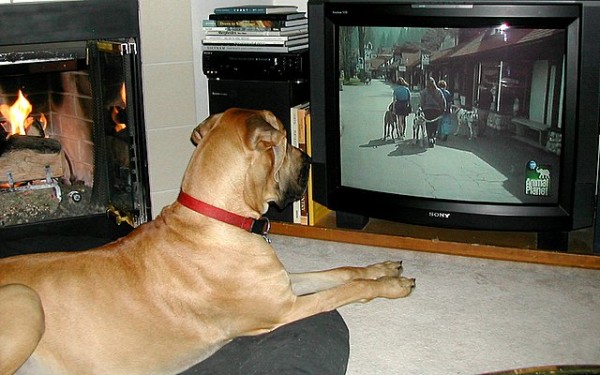We often find that when we watch TV, our pets, for example dogs also sit with us. In your case, you can see and understand what’s happening on TV, but can dogs actually see and understand what’s happening on TV?
We often heard people reporting that their dogs completely ignore what is visible on television, while others report that their dogs are often captivated by events on the TV screen. Often the dogs bark while objects on the TV screen move. Whether or not a dog pays attention to a program on television depends upon a number of factors.
The dog does not interpret the television the same way we do. A dog cannot determine what an object on the screen actually is. But the movement and shapes he is able to see can be pretty intriguing. For example, if we can see a video of a dog running around a field, your dog will see a dark object moving around the screen and this may grab his attention and make him “watch” TV.
The sounds of the television are also likely to gain the attention of the dog, and because they can pinpoint the directional origin of any sound they hear, they will naturally look at the TV. Most dogs, however, will differentiate between the sounds of, for example, a dog barking on TV and a real dog barking. Although unapparent to us, there will be a distinct difference which will render the TV version unimportant to your dog. In this case a dog’s most important sense, that of smell, is not present in television and hence it may affect his/her reaction to stimuli such as the TV that is lacking scents.
On the other side, watching TV of a dog mostly depends upon the dog’s visual abilities. If we reduce the events that we see on the TV screen to its simplest form, the motion that we see really becomes a moving pattern of light across the retina in our eye. At the level of single cells on the retina, a moving target appears to be a flicker. As the image of the target passes over a visual receptor in the eye and then moves on, it causes a momentary increase or decrease in brightness.
There are fewer cones (color vision cells) in a dog’s eye than in a human’s eye. And as dogs do have many more rods (light and motion detectors) than we do, so although they see a limited spectrum, they can see better at night. Dogs can also see flickering light better than we can, which means they might even be able to see individual frames in a television sequence where we would see a continuous scene.
[ttjad keyword=”google-tv”]




